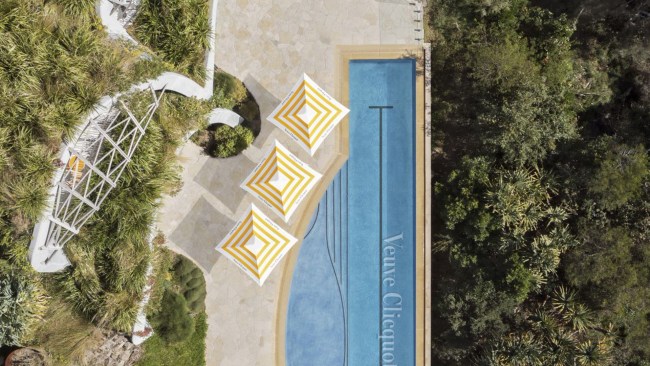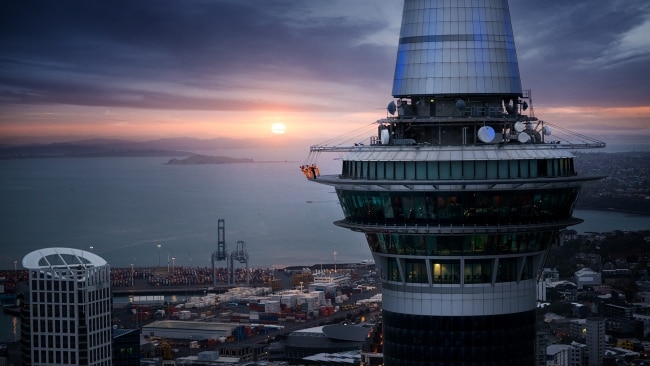Oceans away in the Maldives
The newest style of accommodation in the Maldives is a series of private villas perched above the ocean.
AT the end of the villa's infinity-edge pool is a submerged bench, set at precisely the right height to sit, lean forward and place one's elbows on the tiled rim. The underwater seats at swim-up pool bars seem old (sun) hat compared with this splendid arrangement at Angsana Velavaru in the Maldives. It feels like sitting on a sofa, albeit one that has migrated from the customary lounge room to a perch above a lagoon that merges with the horizon. It is total immersion in a cosmos of liquid blueness.
There is much that is splendid about this resort but its 33 new In Ocean Villas, or IOVs, as staff happily call them, are the icing on an already tasty cake. I love this shorthand idea of an IOV; it sounds like a medical procedure. Not so much pain management as a drip that feeds feel-good luxury into one's system. In my IOV, I am hooked up to some other-worldly notion of time and place.
Days pass at a soporific pace under polished blue skies and in pitiless heat. The tropical sun slashes the water into glittery fragments; sunglasses, shady hat and SPF are de rigueur. Pared down to sandals and sarong, I seem to have lost the ability to make decisions of any import. Even choosing breakfast from a piled buffet is tiring. A lone traveller surrounded by honeymooners, water is my preferred partner. I dip in my IOV's long and lovely pool, climb down the steps into the sea when the tide is high and befriend the lagoon's locals. Tiny sharp-nosed blue fusiliers shoot about like released arrows; there are species with names as irresistible as moorish idol, bullet-head parrotfish and black-footed clownfish.
Best of all, one dusk I peer down from the deck and through the cutting shadows spot a leopard ray, stylishly outfitted in its spotty garb. Seconds later it is gone, the sun has set in one swift kerplonk and the water has darkened to an unknowable black.
Angsana is a branding of the Singapore-headquartered Banyan Tree hotels and resorts group, which has made a big investment in this property in the South Nilandhe atoll, a 40-minute seaplane ride from Male, island capital of the Maldives. Flights from Australia via Singapore arrive late at night, so many guests book tandem stays, zooming by speedboat to nearby sister properties Banyan Tree Vabbinfaru or Angsana Ihuru to spend the first night or two. Or there's the option of boarding the mega-luxe six-cabin Banyan Velaa, a 30m seafaring ketch, and spending your arrival night bobbing near the airport.
The 113-room Angsana Velavaru has excellent facilities and accommodation on its main island (especially the deluxe beachfront pool villas with their orange-painted garden feature walls, which look oddly Moroccan). The IOVs, which opened in July, sit satellite-like in two double-sided wings, 1km across the lagoon, with their own reception pavilion, Italian-influenced Azzurro restaurant, bar and small spa. Each villa is named for a local fish in this King Neptune's domain and Velavaru means turtle. In tune with the name, the island has a marine laboratory that runs a research and protection program for green sea and hawksbill turtles.
Guests are whisked across the defiantly blue lagoon between the resort's two hubs by a jaunty open-sided ferryboat with a captain who steers the wheel with his bare feet. The crossing takes about five minutes but is such fun I feel like zipping back and forth, just for the heck of it. The main island takes seven minutes to walk around and feels lightly tethered in the sea; everything is secured by water in the Maldives, where there are year-round temperatures of 29C to 32C and the fringing lagoons have a bath-tub cosiness. It's agreeable territory for swimmers and snorkellers who like to take aquatic exercise in shallow and safe surrounds.
The nation consists of 1190 coral islands spread across 26 atolls; that familiar word atoll is from the local Dhivehi language. Tourism is its mainstay and about 100 islands host resorts, but it's not an untroubled universe: if ocean levels rise as predicted, the nation will be submerged. The atoll of Maduvari could be gone within two decades.
In September, President Mohamed Nasheed addressed world leaders gathered at the UN headquarters in New York and urged them to protect the future of front-line countries such as the Maldives. He said an ambitious new treaty on greenhouse gas reductions must be reached at December's UN climate change conference in Copenhagen, which seeks to limit average global temperature increases to less than 1.5C above pre-industrial levels.
"To do otherwise would be to sign the death warrant for 300,000 Maldivians," Nasheed said. He has pledged that the Maldives will be the first carbon-neutral country in a decade. "In order to do that, we are determined to formulate a survival kit, a carbon-neutral manual that would enable others to replicate in order that all of us together might just about save ourselves from climate catastrophe."
In the meantime, the average traveller is sequestered from such concerns and the nation is critically dependent on tourism. And such is the level of competition between resorts that to be taken seriously at five-star level you simply have to offer bungalows on stilts above the water. This style of accommodation has become the poster image for this Indian Ocean nation and most couples will settle for nothing less. At the best examples, such as the groovy Huvafen Fushi, all villas come not just with ladder access to lagoons -- ensuite oceans, if you like -- but private pools set ondecks.
Angsana Velavaru has opted for this premium template in its IOVs and added a cushion-strewn hammock arrangement suspended over the water beside the pool (it looks like a small trampoline) and boxy rooftop belvederes with encircling views. You can dine up in these eyries, surrounded by stars and the plip-plops of flying fish, as room-service chaps deliver myriad courses or a chef arrives to barbecue your dinner. This could involve the booty from your night fishing expedition: the likes of grouper, red snapper, skipjack and barracuda are routinely caught on handlines by even the silliest fishing duffers.
Each IOV has a blue-tiled pool that's significantly longer than the plunge-sized norm. But I do find it a little strange that the villas, and their jutting pools, are configured in straight lines, not angled for more privacy; clearly visible from my pool, my Japanese honeymooner neighbours swim in sunglasses and, one evening, she dons fluffy yellow-and-black antennae and buzzes up and down like a bumblebee while he videos her. On the other side, a Chinese couple put on full snorkelling gear each morning but they never venture into the lagoon, seemingly content to float on their stomachs in their pool, looking at the tiled floor through masks.
But perhaps I am the one who is the oddest of the lot, here alone. Both couples wave as they photograph me. No doubt my images have been emailed hither and thither. Exhibit A: one Australian woman of a certain age, marooned like Nancy No Friends in the most romantic of resorts. I ring my husband to complain I feel like an old stuffed trout but he's oddly unsympathetic at my plight.
New arrivals are being greeted: as they disembark from the seaplane from Male, they are welcomed with coconut marshmallows and dishes of raspberry sorbet. I have farewelled my Japanese neighbours (she has shed the bumble-bee costume, thankfully, for their departure) and am spending the morning in my villa.
It's a spacious configuration (depending on category, villas range from 175sqm to 290sqm) with separate lounge cum dining room, king-sized bedroom and massive bathroom opening via glass doors to the lagoon. Angsana's trademark colours are tangerine and lime and there's a surfeit of the former, which when married with dark wood and black finishes gives the room the appearance of a gigantic licorice allsort.
The look is contemporary, sort of a Manhattan loft transplanted to a reef. There are few, if any, direct Maldivian references (the first signal is that the villas are not thatched, as per the local resort norm); some guests may not like such cultural anonymity but aquatic motifs do abound, particularly coral, which appears as tracery in the drum lampshades and in bold ornamental murals. Even the black mats on the white-tiled floors have been funked up with wavy orange patterns to represent coralgardens.
On one windy morning, I wake early and the outdoor awning is billowing and clinking and it feels as if the villa is about to set sail into the briny yonder. Living above the water in a little house on stilts, one becomes fascinated by the elements; it's much better than watching the Weather Channel. Angsana Velavaru staff invariably have a greeting about the day's forecast and are downcast when grey clouds or rain interrupt proceedings on the IOV planet of perfection. But when the wind gets going, one repairs to the spa.
The main facility, on the resort island proper, features nine outdoor treatment pavilions walled with bamboo and spread amid a sandy garden. Each is named for a bright tropical bloom, from allamanda and sunflower to lotus and jasmine. The semi-alfresco pavilions are baubles of colour, with their hot pink curtains, lime and buttercup cushions and deep purple bed dressings. Guests are greeted with ginger tea and orange slices and everything smells of sandalwood and fabulously scentedflowers.
Treatments run the gamut from rubs and scrubs to massages and facials. The menu is similar to those found at other Angsana and Banyan Tree properties and the emphasis is on organic ingredients. If you don't float out of here -- indeed out of the resort and on to the plane home -- on happy new feet, all fresh and shiny and smiling like a loon, then you are far too cool a customer.
Susan Kurosawa was a guest of Singapore Airlines and Angsana and Banyan Tree Hotels&Resorts.
Checklist
Singapore Airlines flies daily to the Maldives via Singapore. More: 131 011; www.singaporeair.com.au. Pinpoint Travel-Singapore Airlines Holidays has a package with return economy class fares from selected Australian ports to Male via Singapore; return speedboat transfers from Male airport to Angsana Ihuru, one night at Angsana Ihuru (with breakfast), return seaplane transfers to Angsana Velavaru and seven nights in an In Ocean Villa, with breakfast. $7295 a person twin-share; valid to stay February 1 to March 31; book by November 1. More: 1300 767 227.
Classes are conducted at Angsana Velavaru by a resident marine biologist and guided snorkelling safaris further instruct guests on protecting corals and fish. More on Angsana Velavaru's marine laboratory: www.banyantree.com/csr.



